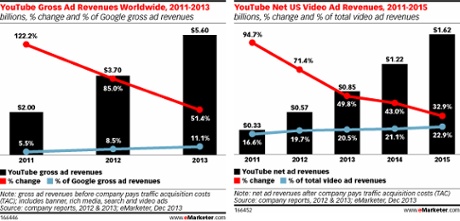YouTube ad revenues tipped to jump 51% to $5.6bn in 2013
Marketer expects video service to account for 11.1% of parent company Google's ad revenues this year
Google has never revealed how much money YouTube makes since buying the online video service for $1.65bn in 2006. That doesn't stop analysts and research firms taking guesses.
The latest is eMarketer, which has published its first estimates for YouTube's advertising revenues today. The company predicts that YouTube's gross ad revenues will rise 51.4% to $5.6bn in 2013, accounting for 11.1% of Google's total.
Once YouTube has paid ad partners and video creators their share, its net ad revenues are still expected to reach $1.96bn this year, up 65.5% compared to 2012's $1.18bn.
eMarketer has also broken out YouTube's net ad revenues in the US, estimating that they'll reach $1.08bn in 2013, with $850m of those coming from video advertisements. The company thinks this will give YouTube a 20.5% share of all US video advertising revenues for the year.
"Predicts", "estimates", "thinks" – this is all guesswork, so why should people trust eMarketer's analysis? The company says it is informed guesswork based on "hundreds of datapoints and studies about YouTube revenues, ad impressions, rates, usage and other factors collected from research firms, investment banks, company reports and interviews with industry executives".
youtube's ads and revenues are expected to rise so much when this year has ended, The company feels that YouTube's gross ad revenues will rise 51.4% to $5.6billion in 2013 accounting for 11% of googles total. They've paid there ad partners and video creators their share. This shows how popular people in the society believe internet is, as millions of people especially know when they want to listen to a song the first stop they'd go to is youtube. Therefore businesses/companies realise that if they advertise on youtube they'll be able to increase the awareness of what they're advertising to their customers. In return it's a big advantage for YouTube as they are able to receive high revenue for the amount of people who want to advertise on a popular site where majority of the public are immune to going on.

